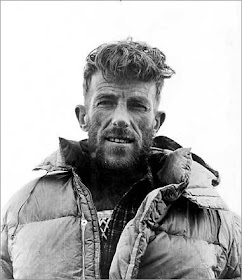 I recently had the chance to meet William Kroll, the man behind Tender Co. a small yet detail-rich and laboriously fabricated denim line consisting presently of a pair of jeans, a blanket-lined rail workers jacket, printed knits and beautifully constructed belts of 1/4" thick leather.
I recently had the chance to meet William Kroll, the man behind Tender Co. a small yet detail-rich and laboriously fabricated denim line consisting presently of a pair of jeans, a blanket-lined rail workers jacket, printed knits and beautifully constructed belts of 1/4" thick leather.
You only need spend a few minutes with the earnest and studious William to get that his endeavor is a highly personal one, steeped in deep reverence for the process and layered in subtle reference ranging from family history to modern art. Every step along the way has been thought and re-thought as to the construction methods to dyeing to the provenance of each piece in the collection. He is a trove of knowledge and ideas and at times, it's hard to keep up with his near stream of consciousness style. If I had taken notes, they may look more like a diagram, following his thoughts from Orozco to mythical beasts like the Peryton and Chonchon.
William, while using British Heritage workwear from the Great British Steam Age as a touchstone, isn't strictly interested in simply reproducing vintage clothing. He rather prefers to take tried and true methods and ask if they could be done better. Where do jeans blow out most? In the crotch so why not fold and sew the inseam the opposite way? He's a tinkerer of the highest order, and if he's not bending wire to prototype the wonderfully conceived belt buckles, he's getting his hands dirty, assisting in the garment dyeing process.
The pieces are garment-dyed in vegetable indigo, one at a time, made of 16oz unsanforized japanese selvedge denim(sewn with cotton thread to take on the dye), cut and sewn in England. The jeans have a straight, roomy fit. A New Standard copy, it is not, and William says a second fit is in the works. The belt oak bark leather from a tannery in East Devon where leather has been made, largely by the same methods, since the times of the Roman Empire. (yep. That old.) Buttons(removable on the jacket) and belt hardware cast from solid brass nearby in Devon.
What William has created in Tender is a personal and exhaustively conceived, sourced and manufactured celebration and reinterpretation of UK heritage not unlike that which has been ongoing here in the states with our own US Made embracing of the age old. It gives a different perspective on what, perhaps, we think, as of late, to be very American. Click over to MADEBYTENDER and have a look around.
Tender will be crossing the pond, available in the states late Summer at a select handful of quality shops. 

























 Perhaps it's the recent cold snap. And perhaps attendant to the fact that Sir Edmund Hillary and Sherpa Norgay Tenzing accomplished the near impossible, summiting Mount Everest(ཇོ་མོ་གླང་མ) on May 29th, 1953, with unfalterng style (see Nigel Cabourn). In either case, take notes. It's cold out there.
Perhaps it's the recent cold snap. And perhaps attendant to the fact that Sir Edmund Hillary and Sherpa Norgay Tenzing accomplished the near impossible, summiting Mount Everest(ཇོ་མོ་གླང་མ) on May 29th, 1953, with unfalterng style (see Nigel Cabourn). In either case, take notes. It's cold out there.




























































